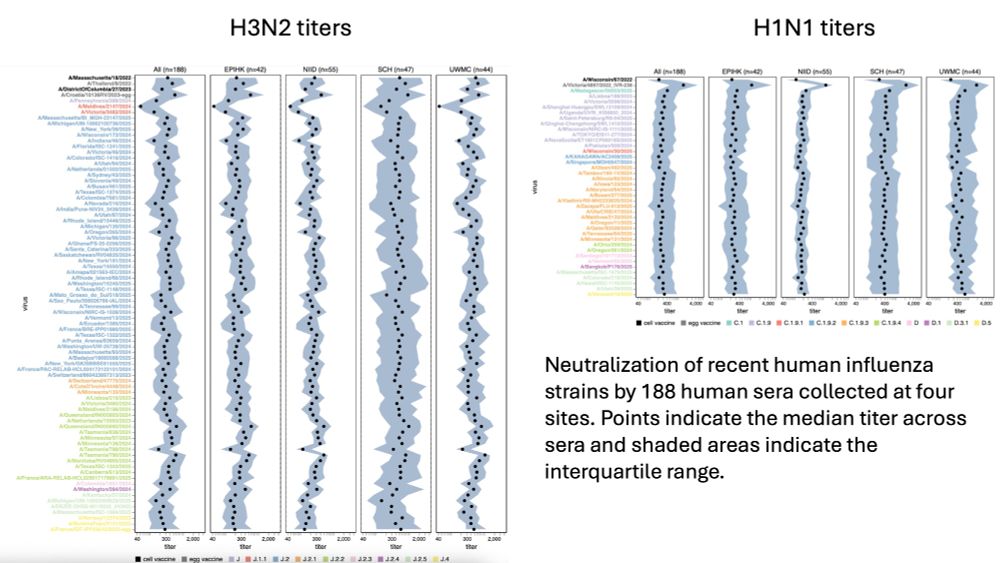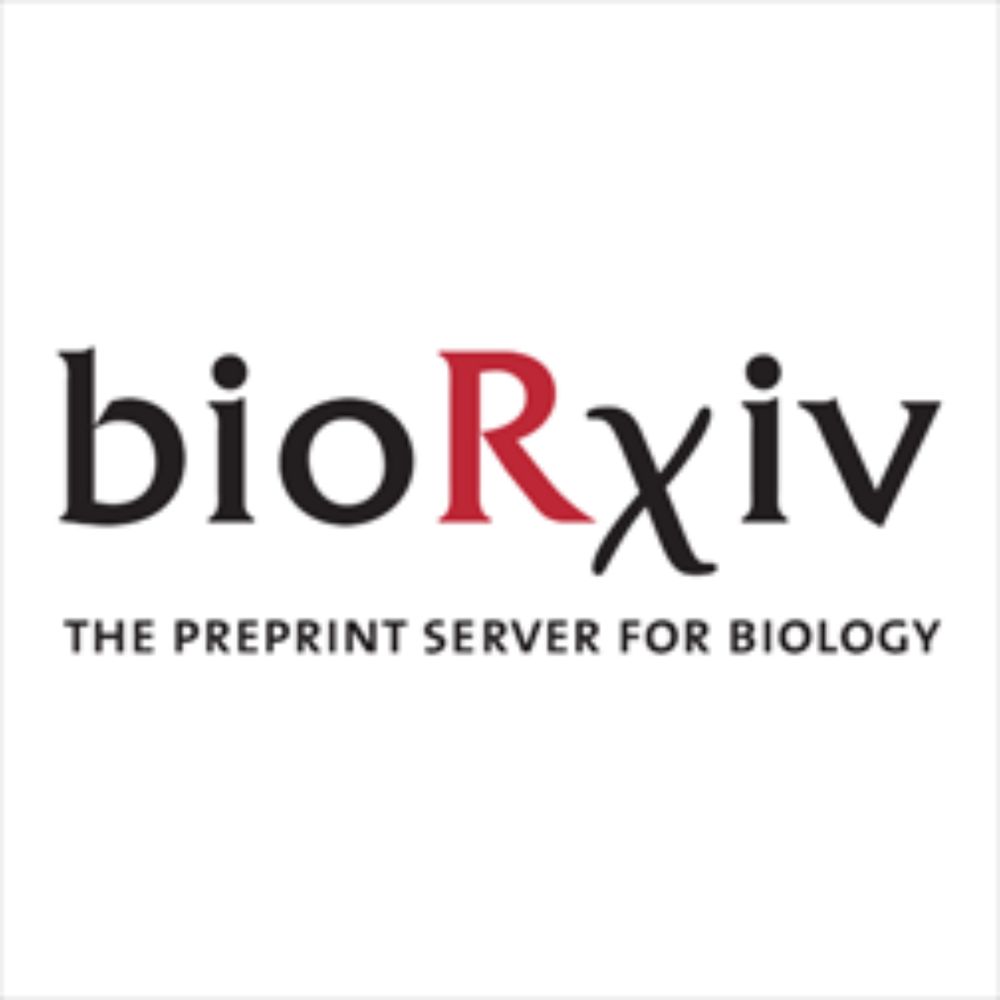Finally, we plan to repeat this effort in ~6 months prior to next vaccine strain selection. If you have sera cohorts that you think would be well suited for this type of study and are potentially interesting in collaborating, please feel free to reach out.
08.09.2025 21:55 — 👍 8 🔁 1 💬 0 📌 0
Thanks to @ckikawa.bsky.social & @huddlej.bsky.social for leading study, also: Andrea Loes, Sam Turner, Jover Lee, Ian Barr, Ben Cowling, Jan Englund, Alex Greninger, Ruth Harvey, H Hasegawa, Faith Ho, K Lacombe, Nancy Leung, Nicola Lewis, Heidi Peck, Shinji Watanabe, Derek Smith, Trevor Bedford
08.09.2025 21:55 — 👍 6 🔁 0 💬 1 📌 0

GitHub - jbloomlab/flu-seqneut-2025
Contribute to jbloomlab/flu-seqneut-2025 development by creating an account on GitHub.
Many more analyses are possible w these data. But we have made all data & code available now at github.com/jbloomlab/fl...
Reason is to provide near real-time titer data that can be leveraged by scientific community for real-time decisions like vaccine strain selection.
08.09.2025 21:53 — 👍 6 🔁 1 💬 1 📌 0

Above visualizations just scratch surface of data: there is tremendous heterogeneity across sera from different individuals not easily summarized by median/mean.
Indeed, we previously found this heterogeneity may be important for influenza evolution: elifesciences.org/reviewed-pre...
08.09.2025 21:53 — 👍 4 🔁 1 💬 1 📌 0
auspice
Working w @huddlej.bsky.social & Trevor Bedford, we mapped neutralization titers on interactive Nextstrain trees to visualize neutralization across subclades and natural mutations.
See:
nextstrain.org/groups/blab/...
nextstrain.org/groups/blab/...
08.09.2025 21:52 — 👍 4 🔁 1 💬 1 📌 0

We then measured how 188 human sera recently collected at four different sites neutralized all 140 influenza strains in library.
Titers are summarized below; can be examined interactively at jbloomlab.github.io/flu-seqneut-... & jbloomlab.github.io/flu-seqneut-...
08.09.2025 21:51 — 👍 5 🔁 1 💬 1 📌 0

In spring of 2025, we designed library of naturally occurring human seasonal influenza strains that represented diversity of available sequences at that time; this library continues to cover most sequenced diversity of H3N2 and H1N1 hemagglutinin today.
08.09.2025 21:51 — 👍 6 🔁 1 💬 1 📌 0

To do this, we used sequencing-based neutralization assays that measure many neutralization curves simultaneously (journals.asm.org/doi/10.1128/... & elifesciences.org/reviewed-pre...)
Approach enabled one grad student (@ckikawa.bsky.social) to measure ~26,000 neutralization curves in ~5 months.
08.09.2025 21:51 — 👍 5 🔁 1 💬 1 📌 0

But because it takes time to perform experiments, measurement of how current strains are neutralized by human serum antibodies can lag timeline for vaccine strain selection.
Our goal was to use new approach to characterize human antibody landscape at scale in near real-time.
08.09.2025 21:49 — 👍 6 🔁 1 💬 1 📌 0
As background, seasonal influenza evolves to erode antibody immunity.
Viruses w more antibody escape spread in human population & people more likely to be infected by strains their antibodies neutralize less well.
Vaccine updated bi-annually to keep pace w viral evolution.
08.09.2025 21:49 — 👍 6 🔁 1 💬 1 📌 0

Data in interactive form at dms-vep.org/CHIKV-181-25...
Thanks to Xiaohui Ju for leading study
Special thanks to @msdiamondlab.bsky.social for help
Also Will Hannon, Caelan Radford, Brendan Larsen, Daved Fremont, Ofer Zimmerman, Tomasz Kaszuba, Chris Nelson, Israel Baltazar-Perez, Samantha Nelson
04.09.2025 23:20 — 👍 6 🔁 0 💬 0 📌 0
Overall, these results shed light on how Chikungunya virus naturally infects cells from highly diverse species.
Sequence-function information can aid in immunogen engineering, and loss-of-tropism mutants could be useful in vaccines as well.
04.09.2025 23:17 — 👍 11 🔁 1 💬 1 📌 0

After using pseudoviruses & reporter particles to show mutations *loss* of function, we engineered into Chikungunya virus: mutants lost ability to infect human or mosquito cells.
So we reduced natural tropism for both human & mosquito cells to just one type of cell.
04.09.2025 23:16 — 👍 3 🔁 0 💬 1 📌 0

We next used non-replicative single-cycle alphavirus reporter particles (which provide another safe way to study mutations) to validate that mutations identified in deep mutational scanning indeed specifically impaired entry in human or mosquito cells only.
04.09.2025 23:16 — 👍 2 🔁 0 💬 1 📌 0

Sites where mutations specifically impair entry in 293T-MXRA8 cells mostly at MXRA8 binding interface.
We also find sites where mutations specifically impair entry in C6/36 cells. Although mosquito receptor unknown, we hypothesize these sites at its binding interface.
04.09.2025 23:15 — 👍 3 🔁 0 💬 1 📌 0

Most mutations similarly affect entry in all three cells, but some have cell-specific effects.
For instance, mutations at E2 site 119 are generally tolerated in C6/36 and 293T-TIM1 cells, but deleterious in 293T-MXRA8 cells.
(See dms-vep.org/CHIKV-181-25... for interactive plot.)
04.09.2025 23:15 — 👍 2 🔁 0 💬 1 📌 0
We then measured how mutations affect entry in two other cells: the mosquito cell-line C6/36, and 293T cells expressing TIM1 which enables envelope protein independent cell binding by virion associated phosphatidylserine.
04.09.2025 23:14 — 👍 3 🔁 0 💬 1 📌 0

We first measured how mutations affect entry in 293T cells expressing human receptor MXRA8.
Below is constraint mapped on structure; see dms-vep.org/CHIKV-181-25... for interactive heatmap of these data.
04.09.2025 23:14 — 👍 3 🔁 0 💬 1 📌 0

We used pseudovirus deep mutational scanning to measure effects of all mutations to envelope proteins in context of single-cycle pseudotyped particles that provide a safe way to study viral protein mutations outside context of fully infectious virus.
04.09.2025 23:13 — 👍 2 🔁 0 💬 1 📌 0

Chikungunya virus enters cell using its envelope proteins, which are also target of neutralizing antibodies and vaccine design.
A receptor for these viral proteins in mammalian cells is the protein MXRA8, but receptor in mosquito cells is unknown.
04.09.2025 23:13 — 👍 2 🔁 1 💬 1 📌 0

As background, Chikungunya virus has transmission cycle that involves infecting both mosquitoes & humans or other primates.
Infection can cause fever and severe joint pain in humans.
Outbreaks are growing due to expanding mosquito range: www.nytimes.com/2025/08/19/h...
04.09.2025 23:12 — 👍 4 🔁 2 💬 1 📌 0
Pseudovirus deep mutational scanning of SARS-CoV-2 spike from KP.3.1.1 strain
Data, figures, and analysis for KP.3.1.1 spike .
All data available in interactive form at dms-vep.org/SARS-CoV-2_K... and we encourage exploration of that site.
Study led by the incomparable @bdadonaite.bsky.social, w help from Sheri Harari, Brendan Larsen, Lucas Kampman, Alex Harteloo, Anna Elias-Warren, & Helen Chu.
20.08.2025 05:28 — 👍 8 🔁 3 💬 0 📌 0

Finally, we measured how mutations affect neutralization by three relevant monoclonal antibodies. As shown below, all antibodies adversely affected by mutating site 505 which fortunately remains highly constrained for ACE2 binding. We discuss this interesting site more in preprint.
20.08.2025 05:26 — 👍 7 🔁 2 💬 1 📌 0

We used this fact to estimate how much mutations at each site affect RBD up-down motion, as shown below.
Many of these sites have mutated during SARS-CoV-2 evolution in humans, demonstrating importance of RBD motion and its effects on ACE2 binding & antibody neutralization.
20.08.2025 05:26 — 👍 9 🔁 3 💬 1 📌 0

This tradeoff between serum antibody escape and ACE2 binding is because mutations that put the RBD more up enable ACE2 binding but also promote antibody binding. Mutations that put the RBD more down do the opposite.
20.08.2025 05:25 — 👍 10 🔁 3 💬 1 📌 0

Some mutations outside the RBD have a strong effect on serum antibody neutralization. But for ACE2-distal or non-RBD mutations, there is a strong tradeoff between serum antibody escape and ACE2 binding as shown below.
20.08.2025 05:25 — 👍 8 🔁 3 💬 1 📌 0

Despite imprinting, in some individuals recent infection or vaccination appreciably shift immunodominant neutralizing epitopes.
So new exposures are altering neutralizing serum antibody repertoire, although our data do not define mechanism (see preprint for hypotheses).
20.08.2025 05:25 — 👍 10 🔁 2 💬 1 📌 0

We measured how mutations affected neutralization by sera collected from humans before or after vaccination or infection w recent JN.1-descendant variant. Key sites of escape are shown below; some of the sites (eg, 475 and 478) are mutated in very recent variants.
20.08.2025 05:24 — 👍 8 🔁 2 💬 1 📌 0
scalable data analysis, modeling, AI, software design at HHMI Janelia
https://mastodon.social/@herrsaalfeld
Evolutionary Biology @ Emory
https://biology.emory.edu/people/bios/faculty/bazykin-georgii.html
She/her. Award-winning independent health journalist covering medical news for The New York Times, NBC News, Scientific American, AARP and others. Loves dogs and cats.
Structural virologist who also loves sports
@veeslerlab.bsky.social
Frustrated football player, I moved to a less relevant work: microbiologist interested on mobile genetic elements
RNA Virologist working on zoonosis
https://eichler.gs.washington.edu/
Graduate student at the University of Illinois.
I like antibodies, national parks and running:)
I'm also an eLife community ambassador! @elifecommunity.bsky.social
Human B cell responses to emerging pathogens 🦠
Icahn School of Medicine at Mount Sinai, NYC 🏙 🚕 🗽🍎
www.coelholab.com
virus evolution / phylogeny / epidemiology
Taiwanese. Previous @duke-nus @UoGlasgow. Current @twCDC.
https://yaotli.github.io
Chemical Biologist. Loves probes, hates TB.
Genomics, Cell Biology, Technology, Innovation, Bay Area Sports, Good Food, Progressive Politics, Travel, Truth and Dogs.
All opinions are my own.
Head of Virology at Charite - Universitätsmedizin Berlin
Postdoc in computational genomics studying RNA viruses at Cambridge. She/Her https://orcid.org/0000-0002-8400-6922
Assistant Professor @ulaval.ca; Tier 2 Canada Research Chair in Structural Systems Biology; Focused on virus-host interactions using structural biology
Paleontologist. Developmental Biologist. Anatomist. Polar wanderer. Telling people that they are fish since 2008.
Evolutionary and Mathematical Biology, sequence structure and function, genomes evolve, statistical theory and knowledge, empirical-theoretical interface, communication of evolutionary genetics, collaboratives, the mind-body problem, humanism





















